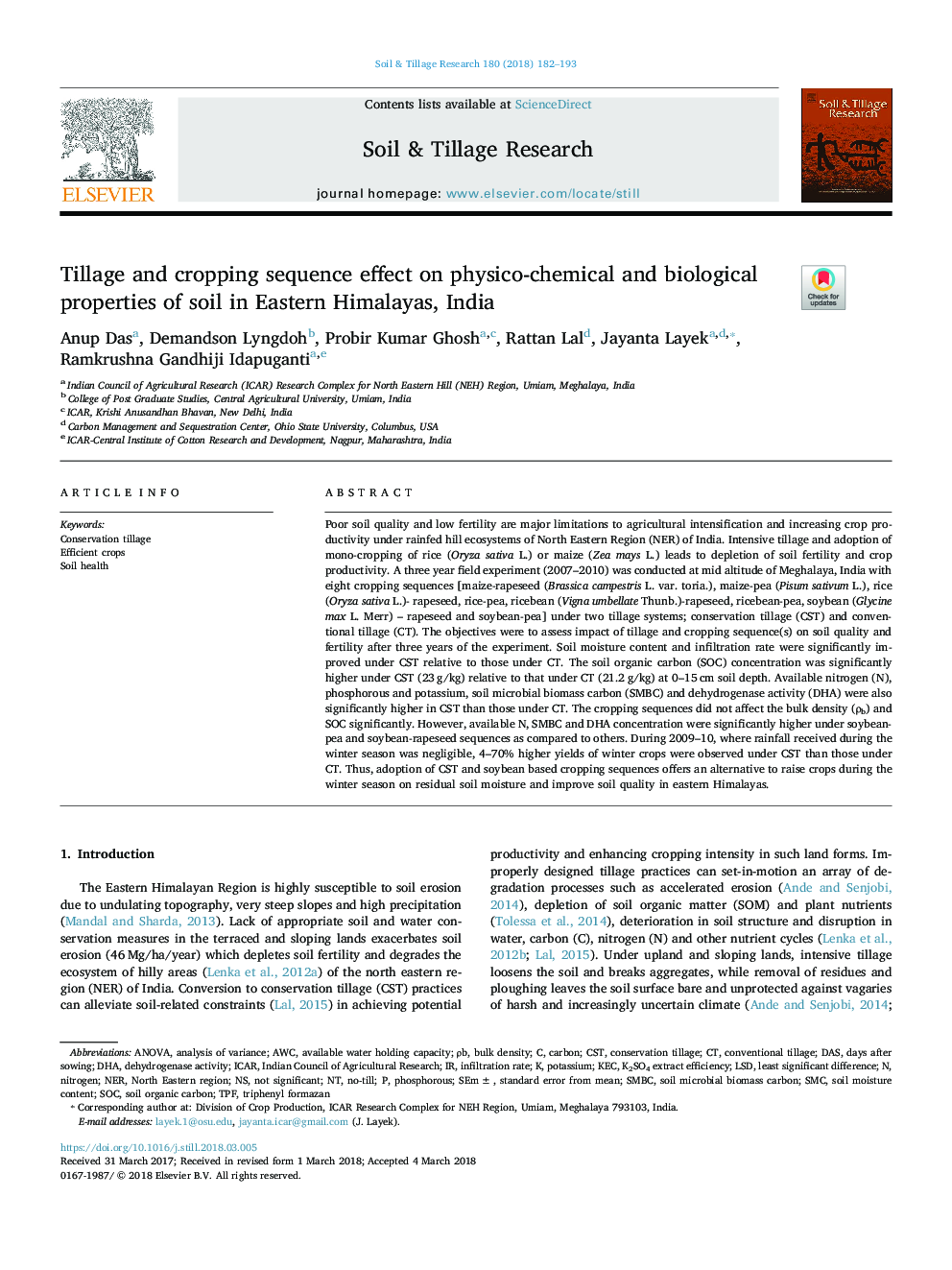| کد مقاله | کد نشریه | سال انتشار | مقاله انگلیسی | نسخه تمام متن |
|---|---|---|---|---|
| 6773106 | 1431823 | 2018 | 12 صفحه PDF | دانلود رایگان |
عنوان انگلیسی مقاله ISI
Tillage and cropping sequence effect on physico-chemical and biological properties of soil in Eastern Himalayas, India
ترجمه فارسی عنوان
گیاهان کشت و زراعی بر خصوصیات فیزیکی، شیمیایی و بیولوژیکی خاک در شرق هیمالیا، هند
دانلود مقاله + سفارش ترجمه
دانلود مقاله ISI انگلیسی
رایگان برای ایرانیان
کلمات کلیدی
SMBCICARAWCSMCTPFLSDρbDASCSt - CSTNER - DOWNNo-till - بدون بهanalysis of variance - تحلیل واریانسANOVA - تحلیل واریانس Analysis of variancebulk density - تراکم فلهleast significant difference - حداقل تفاوت قابل توجهیConservation tillage - خاکورزی حفاظتیDHA - دوکوساهگزائنوئیک اسیدdays after sowing - روز بعد از کاشتSoil health - سلامت روانSOC - سیستم روی یک تراشهConventional tillage - شخم زدن معمولیIndian Council of Agricultural Research - شورای تحقیقات کشاورزی هندPhosphorous - فسفرDehydrogenase activity - فعالیت دهیدروژنازSoil moisture content - محتوای رطوبت خاکnot significant - مهم نیستInfiltration rate - میزان نفوذNitrogen - نیتروژنPotassium - پتاسیمCarbon - کربنSoil organic carbon - کربن آلاینده خاکSoil microbial biomass carbon - کربن بیوماس میکروبی خاک
موضوعات مرتبط
مهندسی و علوم پایه
مهندسی انرژی
انرژی های تجدید پذیر، توسعه پایدار و محیط زیست
چکیده انگلیسی
Poor soil quality and low fertility are major limitations to agricultural intensification and increasing crop productivity under rainfed hill ecosystems of North Eastern Region (NER) of India. Intensive tillage and adoption of mono-cropping of rice (Oryza sativa L.) or maize (Zea mays L.) leads to depletion of soil fertility and crop productivity. A three year field experiment (2007-2010) was conducted at mid altitude of Meghalaya, India with eight cropping sequences [maize-rapeseed (Brassica campestris L. var. toria.), maize-pea (Pisum sativum L.), rice (Oryza sativa L.)- rapeseed, rice-pea, ricebean (Vigna umbellate Thunb.)-rapeseed, ricebean-pea, soybean (Glycine max L. Merr) - rapeseed and soybean-pea] under two tillage systems; conservation tillage (CST) and conventional tillage (CT). The objectives were to assess impact of tillage and cropping sequence(s) on soil quality and fertility after three years of the experiment. Soil moisture content and infiltration rate were significantly improved under CST relative to those under CT. The soil organic carbon (SOC) concentration was significantly higher under CST (23â¯g/kg) relative to that under CT (21.2â¯g/kg) at 0-15â¯cm soil depth. Available nitrogen (N), phosphorous and potassium, soil microbial biomass carbon (SMBC) and dehydrogenase activity (DHA) were also significantly higher in CST than those under CT. The cropping sequences did not affect the bulk density (Ïb) and SOC significantly. However, available N, SMBC and DHA concentration were significantly higher under soybean-pea and soybean-rapeseed sequences as compared to others. During 2009-10, where rainfall received during the winter season was negligible, 4-70% higher yields of winter crops were observed under CST than those under CT. Thus, adoption of CST and soybean based cropping sequences offers an alternative to raise crops during the winter season on residual soil moisture and improve soil quality in eastern Himalayas.
ناشر
Database: Elsevier - ScienceDirect (ساینس دایرکت)
Journal: Soil and Tillage Research - Volume 180, August 2018, Pages 182-193
Journal: Soil and Tillage Research - Volume 180, August 2018, Pages 182-193
نویسندگان
Anup Das, Demandson Lyngdoh, Probir Kumar Ghosh, Rattan Lal, Jayanta Layek, Ramkrushna Gandhiji Idapuganti,
